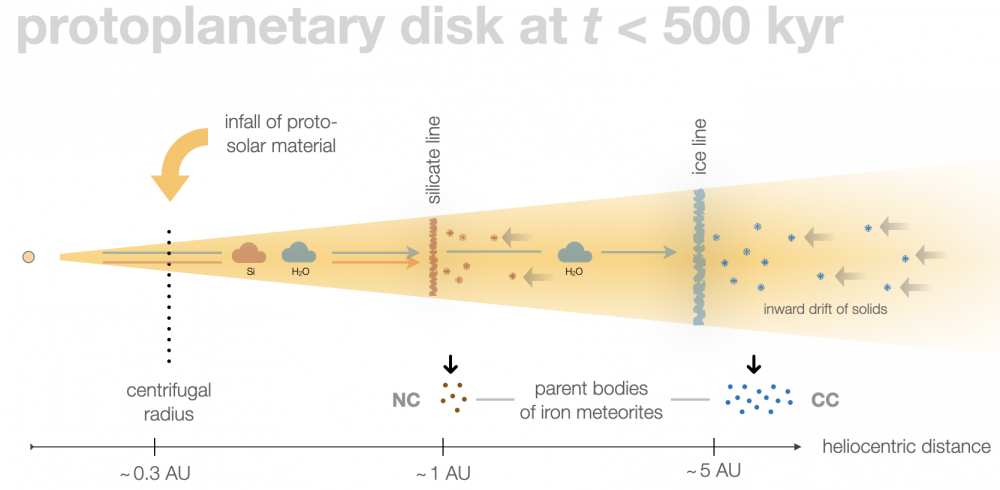Formation of early Solar System planetesimals at two distinct locations at the same time
The formation of the Solar System small bodies, such as the asteroids or the “planetesimals” (the ancestors of the planets), remains a mystery. If the community agrees to think that it is the result of the concentration of dust clusters in the protoplanetary disc, the place and time of this formation remain uncertain. Previous numerical simulations tended to show that the most favorable place for a rapid formation of small bodies would be at the “ice line”, that is to say the place in the disc where the water vapor condenses the form solid ice, at a temperature of about 160 K (about − 110°C). But this result conflicts with the analysis of recovered iron meteorites that once formed the nuclei of the first small bodies of the Solar System. These are divided into two groups of distinct isotopic and chemical properties. These differences argue in favor of two formation sites, not just one, of distinct composition, at different distances from the Sun.
A group of researchers from Observatoire de la Côte d’Azur, Observatoire de Paris – PSL (IMCCE) and Institut de physique du globe de Paris, in an international partnership with colleagues from Caltech (USA) and German universities of Bayreuth and Münster, published an article in Nature Astronomy (december 22, 2021), showing for the first time that the earliest small bodies in the Solar System could have formed in two separate rings, one near the silicate condensation line (around 1000 K), the other near the ice line (around 160 K).
A key part of this explanation is the consideration that the formation of small bodies happens at the same time as the formation of the Sun itself, while the solar nebula was still being fed by a collapsing giant molecular cloud. Because of magnetic braking, the incoming gas falls in the vicinity of the star; thus fed, the protoplanetary disc gradually spreads out. During this radial expansion of the disk, which lasts a few hundred thousand years, the gas cools and its various components gradually condense, forming dust: first silicates, then water ice. The dust is in turn braked by the gas and drift towards the star. In this process, dust naturally accumulates in the protoplanetary disk around the silicate line and the ice line, allowing the formation of planetesimals in these locations, as shown in the attached diagram.

According to the authors of this study, a first reservoir of ice-rich small bodies (with a total mass about thirty times that of the Earth) would have formed near the current orbit of Jupiter, then allowing the formation of giant planet cores, while a second reservoir of silicate-rich small bodies deprived of ice (only a few Earth masses), would have formed near the current orbit of the Earth, then allowing the formation of terrestrial planets. The contemporary formation of these two populations of small bodies with different chemical characteristics is in very good agreement with the observational constraints provided by iron meteorites. It also shows that the process of planetary formation started very early in the solar nebula, at the same time as the formation of the Sun, while our solar system was still being supplied with material by the interstellar medium.
This work is the subject of a press release from the INSU (CNRS):
- https://www.insu.cnrs.fr/fr/cnrsinfo/formation-des-premiers-petits-corps-du-systeme-solaire-dans-deux-anneaux-distincts
- https://twitter.com/INSU_CNRS/status/1480570828119060491
Reference
- A. Morbidelli, K. Baillié, K. Batygin, S. Charnoz, T. Guillot, D.C. Rubie & T. Kleine, “Contemporary formation of early Solar System planetesimals at two distinct radial locations”, Nature Astronomy (2021) – Published 22 December 2021, DOI: https://doi.org/10.1038/s41550-021-01517-7
Contact
- Kévin Baillié (IMCCE/
Observatoire de Paris – PSL) - +33(0)1.40.51.22.69
- Kevin.Baillie@obspm.fr